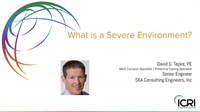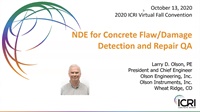
- Presenters:
- Mike Tracy
- Duration:
- 43 Minutes
- Format:
- Audio and Video
- License:
- Access for 6 month(s) after purchase.
- Short Description:
- Increasingly, the Construction Industry is being dramatically impacted globally by internal and external forces. These influences range from acute labor and skill shortages, demographic and urbanization shifts, as well as, the Industry’s conversion from analog-based processes to digital workflows. This presentation will overview ten significant trends which are uniquely affecting the Construction Industry, creating both new challenges and opportunities, while transforming the Construction Industry.
- Price:
- $15.00 - $25.00

- Presenters:
- David G. Tepke
- Duration:
- 42 Minutes
- Format:
- Audio and Video
- License:
- Access for 6 month(s) after purchase.
- Short Description:
- Repairing and extending the service life of concrete in severe environments first requires that one understands what may be considered severe why it may be considered so. This presentation will discuss the ways in which different organizations and technical committees around the world define ‘severe environments’ for concrete structures; types of deterioration mechanisms and materials-related distress that may severely and quickly deteriorate concrete, type of structures with potentially severe environments, and U.S. geographical considerations.
- Price:
- $15.00 - $25.00

- Presenters:
- Kelly Streeter | Daniel Gordeyeva
- Duration:
- 42 Minutes
- Format:
- Audio and Video
- License:
- Short Description:
- This presentation will look at how technology is used to perform condition assessments at height and in places with difficult access utilizing a virtual toolbox that includes a wide range of instruments and tools for non-destructive evaluation and testing, and a fleet of drones, each of which has a different use. The presentation will discuss how to use drones and tools at height; how the industry is using drones in new ways; and how some municipalities are changing policies to adapt, especially with regard to facade inspections.
- Price:
- $15.00 - $25.00

- Presenters:
- Stacia Van Zetten
- Duration:
- 45 Minutes
- Format:
- Audio and Video
- License:
- Short Description:
- The general sentiment around construction and modern technology is that the industry has been slow to embrace it. While this is true of the past, the current and future construction industry is all about modern technology. Not only does technology help to make the industry safer (something that has been a struggle for a very long time), but it is helping contractors to take back control of their budgets, to make smarter choices about project planning and equipment and is, consequently, pushing the green-construction trend forward. The purpose of this presentation is to provide a summary on the current technologies being used in the construction industry with a focus on concrete and to dig even further as to how these can be applied to repair projects. It will provide case studies on how using technology to bring ambient and concrete temperature, relative humidity and strength (among other) data online can help contractors be more efficient.
- Price:
- $15.00 - $25.00

- Presenters:
- Mr. Larry D. Olson
- Duration:
- 41 Minutes
- Format:
- Audio and Video
- License:
- Access for 6 month(s) after purchase.
- Short Description:
- The case-histories based presentation will focus on the use of nondestructive evaluation (NDE) methods to detect flaws and damage in concrete construction. Case histories will be presented for detection and mapping of flaws and damage in concrete such as cracking, delamination, honeycomb, void, corrosion, fire damage, alkali-silica reaction and low strength concrete. The case histories for the concrete structures are anticipated to include parking structures, bridges, buildings and dams. NDE methods will include sonic/ultrasonic, infrared thermography, radar and corrosion technologies where the results in many cases were confirmed by coring. The use of some of the NDE methods for QA of concrete repairs such as epoxy injection and patching will also be discussed.
- Price:
- $15.00 - $25.00

- Presenters:
- H. Peter Golter, P.E. FICRI
- Duration:
- 41 Minutes
- Format:
- Audio and Video
- License:
- Short Description:
- This presentation looks at buildings that are new or being rehabilitated and the impact on making buildings more energy efficient. Starting with the 2012 IBC, and specifically the 2012 IECC portion of the building code and newer versions, the presentation will look at three aspects of the building envelope: Water Resistance, Air Leakage, and Moisture Transmission. It will then compare to identical buildings, the first built in 2000 and the second constructed in 2020. Illustrations and calculations will show how controlling air leakage can have an enormous impact on the service life of the structure, initial cost of construction, and on-going operations. Lastly, the presentation will look at how incorporating simple additions during the repair/rehabilitation process can have a positive impact on the environment as well as the building owner and the building’s constituents.
- Price:
- $15.00 - $25.00

- Presenters:
- Stewart Abrams
- Duration:
- 41 Minutes
- Format:
- Audio and Video
- License:
- Short Description:
- Richard Miller Treatment Plant is a 240 mgd cap. potable water treatment facility located in the California area of the Cincinnati, Ohio, US. After installing an advanced ultraviolet (UV) disinfection treatment system in 2013, GCWW became the largest water utility in North America to use UV light following sand filtration and granular activated carbon. The concrete filter gallery building was originally constructed in 1907 with 26 filters, with a 14-filter addition in 1937 and 7 filters added in 1964. After over 110 years of service, the structures started showing significant signs of deterioration, most commonly concrete spalling and reinforcing steel corrosion. This case study will highlight the methods used to evaluate the structures that involved conventional methods such as sounding, crack mapping, chemical and petrographic examinations, along with technology such as Half-Cell Potential/ICOR, Impact-Echo, Ground Penetrating Radar, and UAS (Drone) services.
- Price:
- $15.00 - $25.00

- Presenters:
- Shayan Yazdani
- Duration:
- 40 Minutes
- Format:
- Audio and Video
- License:
- Short Description:
- Arlington Memorial Bridge is a reinforced concrete spandrel arch bridge that connects Washington, DC and Virginia across the Potomac River. After over 85 years in service, the bridge started exhibiting signs of deterioration, including reinforcement corrosion. As part of a major rehabilitation effort to extend the bridge’s service life, targeted cathodic protection (CP) systems were installed in the arch cross-walls, floors, and under arches to mitigate and prevent corrosion. The implemented CP system consisted of galvanic and two-stage anodes to mitigate corrosion. Galvanic anodes were installed in the repair areas to prevent the ring anode affect and ensure a durable concrete repair. The two-stage anodes were installed in areas of concrete which were actively corroding without signs of concrete deterioration.
- Price:
- $15.00 - $25.00

- Duration:
- 40 Minutes
- Format:
- Audio and Video
- License:
- Short Description:
- This is your opportunity to learn what’s happening with ICRI. 2020 President Mark LeMay will host a recap of the past year, with 2021 President Elena Kessi providing some highlights of what to expect in the near future. We will update you on our newest class of 40 Under 40 recipients and acknowledge our Supporting Members. This is also our opportunity to introduce to you the association’s 2021 Board of Directors and express gratitude to those remarkable volunteers whose technical and administrative committee service ended in 2020.
- Price:
- $0.00 - Base Price

- Bundle:
- Fall Conference Bundle
- Presenters:
- Brent Anderson, P.E.
- Duration:
- 40 Minutes
- Format:
- Audio and Video
- License:
- Access for 6 month(s) after purchase.
- Short Description:
- Dealing with water is always a challenge when constructing a new structure. Whether it is water infiltration that was expected, or water manages to circumvent pre-planned waterproofing methods, it can wreak havoc on the building and interfere with construction schedules. The term “belt and suspenders” is often used in waterproofing and there is a good reason for it. Water chooses the path of least resistance, and many times that path is not discovered until it is too late. There are many methods of water control that can be implemented before, during and after a structure is completed. This presentation will focus on water control methods for new construction that can be implemented during or after the construction process.
- Price:
- $15.00 - $25.00
Please wait ...